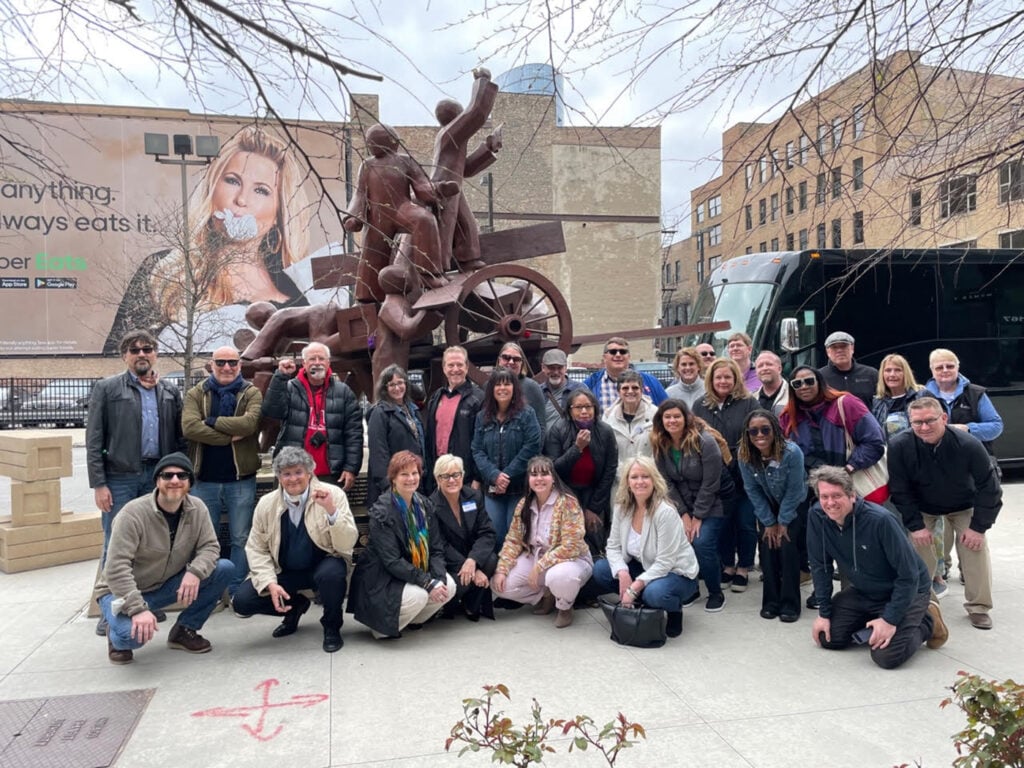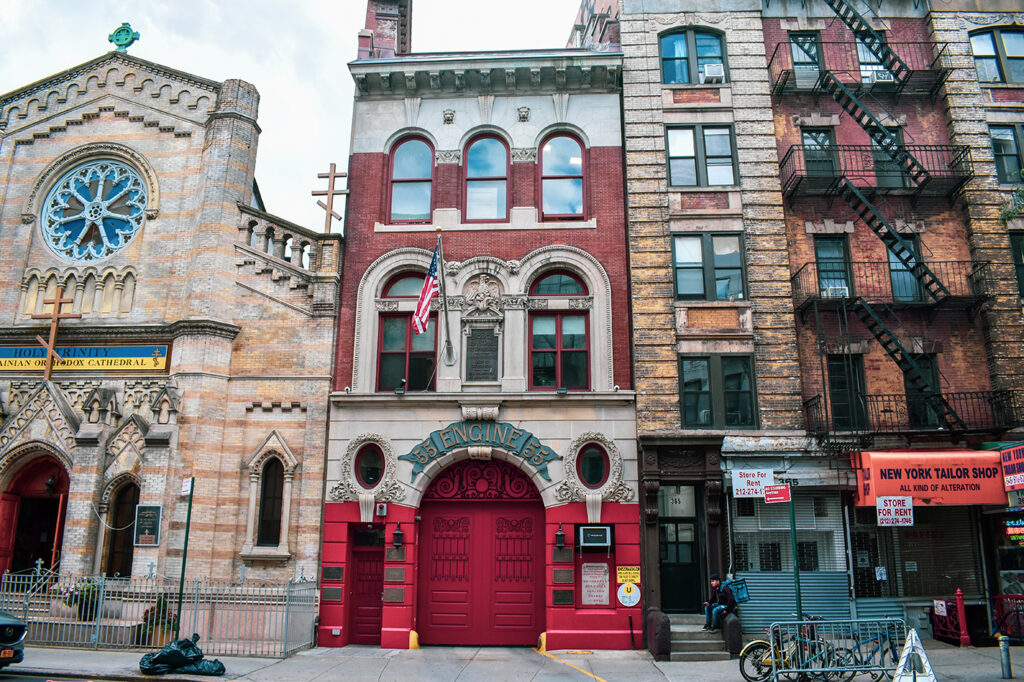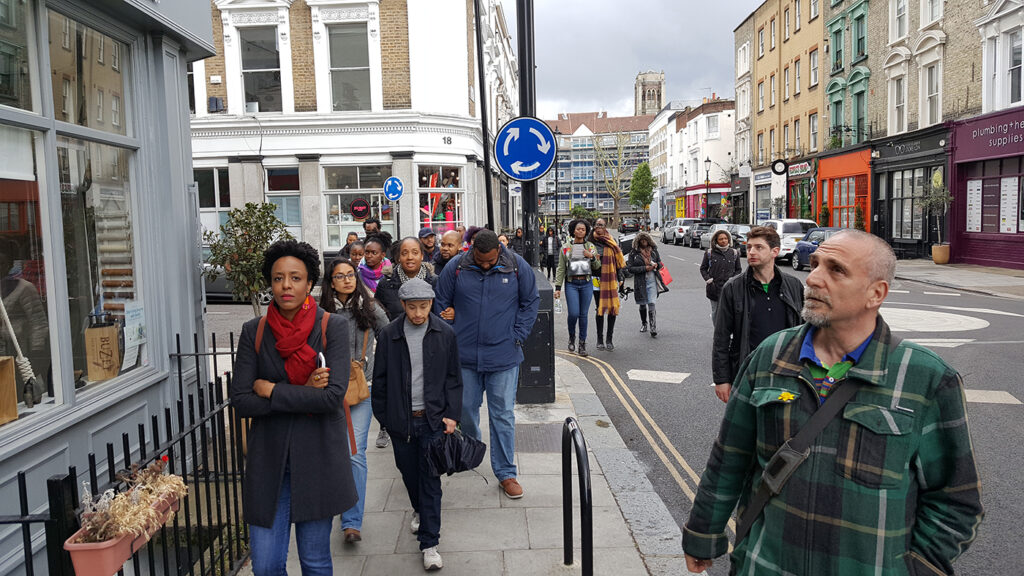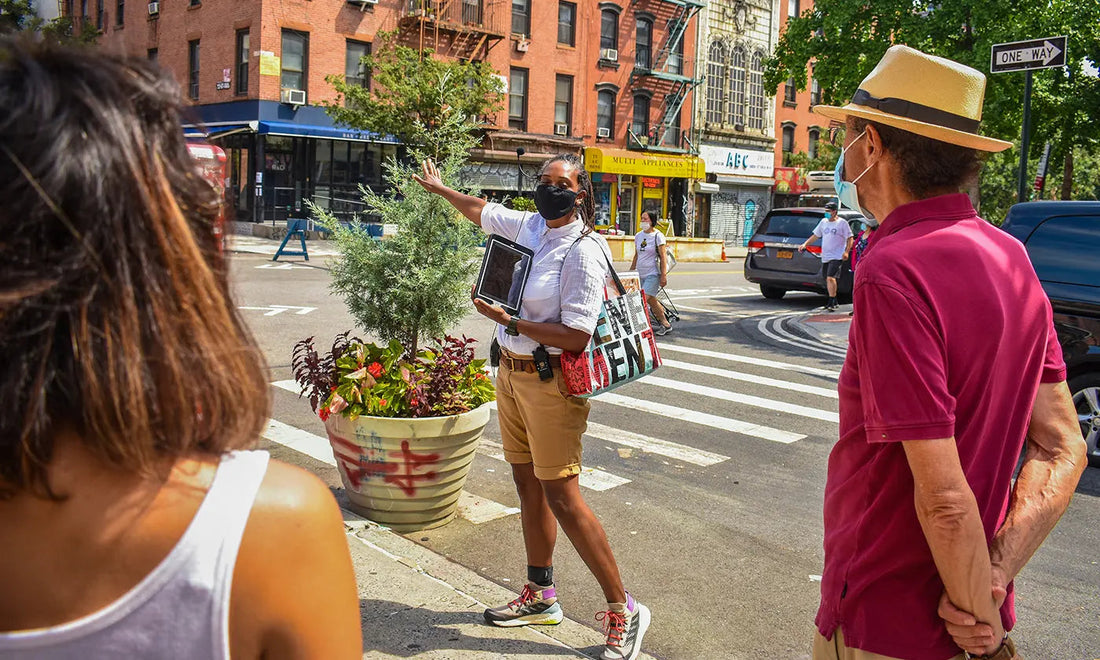On an overcast morning in early May, a group of visitors mills around the corner of North Des Plaines Street and Randolph Street in downtown Chicago waiting for a tour guide. When the guide arrives, rather than heading for top-billed sites, like Millennium Park or the John Hancock Center, the group will kick off at Haymarket Square, wind through the historic Pullman neighborhood, and visit the Union Stock Yard Gate—historical sites central to the labor movement in Chicago (and the broader world).
Led by the Illinois Labor History Society, Chicago’s Labor History Tours offer a “people’s history” of the Windy City and an alternative to the more traditional guided walking or bus tours chock-full of nationalist monuments, displays of institutional or monarchical power, and squares and statues named for White men. A growing number of tours like this one have emerged in cities across the globe in recent years, uncovering local labor histories, Black histories, or other stories of the historical actors often left out of our standard textbooks and tourist experiences.
The term “people’s history” was popularized by historian Howard Zinn in his 1980 book A People’s History of the United States: 1492–Present, which revisits U.S. history from the perspective of Indigenous Americans, enslaved Africans, and the working classes from the arrival of Columbus to the 20th century. Zinn calls people’s history “a history disrespectful of governments and respectful of people’s movements of resistance,” and his text and those that have followed in its tradition tell stories of groups that are underrepresented in curricula, pop culture, and tourist experiences, like city and museum tours.

These histories include working-class histories and the histories of marginalized groups, like migrants, the queer community, and people of color—and all the ways these groups overlap. In the United States and Europe, LGBTQ+-inclusive histories have begun to be introduced to some school curricula. But inclusion is often met with pushback, and anti-LGBTQ+ curriculum laws persist in some states. Meanwhile, people of color are under-represented at every level of classroom education, from the children’s books to the Advanced Placement U.S. history curriculum.
Representation is also uneven in the tourism sector. In 2020, the Black Travel Alliance reported that “Black people are under-represented at all levels within the travel industry,” including destination management organizations, travel-related retail and financial services brands, and travel press. According to data from Zippia, more than three-quarters of travel journalists are White, meaning the stories that we read about travel are also filtered through a White lens.
Organizations that offer tourist experiences rooted in people’s histories seek to disrupt these narratives. “The story of the labor movement, and especially the thousands of events that have built this middle class, are usually not taught well or taught at all,” says Larry Spivack. As president of the Illinois Labor History Society, Spivack says his organization’s mission has been to reclaim the narrative and “tell the story of the profound significance of labor history in the Illinois region.”
Its Labor History Tours are part of this work. The tours are made-to-order for local community groups, union conventions, visiting researchers, or tourists interested in learning more about Chicago’s workers movements, and can be led as walking or bus tours. Spivack, who has been leading tours since the ’90s, long before he became president of the organization in 2006, says everyone who joins him learns something new.
“When people find out that the benefits inured to them in workplaces are from people’s history, organizing, collective action—they’re shocked,” he says. The experience also reminds visitors that everyday people like themselves are historical actors with the power to shape the future. Spivack says visitors often leave the tour wanting to get engaged in their union or organization after hearing the stories of Mother Jones and Lucy Parsons, Chicago-based labor organizers who Spivack says “were part of this historical collective action that gave us a much better society.”

“People are interested in the idea that history is created by people, and that we can be part of that,” says Kathryn Lloyd, senior director of programs and interpretation at the Tenement Museum in New York City. Like the Illinois Labor History Society, the Tenement Museum is committed to introducing visitors to understudied histories. Its guided tours through preserved tenement apartments and neighborhoods on the Lower East Side center on the waves of working-class European, Jewish, and Black migrants who lived in tenement buildings in the 19th and early 20th centuries.
“It’s this idea of looking at the stories of people who weren’t considered important in their time, and really lifting up those stories to see them as essential stories for understanding U.S. history,” says Lloyd of the Tenement Museum’s guiding mission.
During the COVID-19 pandemic, people developed a heightened sense of living through history, which has driven visitors to the Tenement Museum since it resumed programming following pandemic closures. “We really hope to have people come away with the sense that they are also part of history, and we can all be active participants in shaping the future,” says Lloyd.

By encouraging visitors to see themselves as historical actors and raising tough questions about who has been left out of commonly told histories, these organizations also tie their work to current discussions about social justice in tourism, the classroom, and out on the street. “The work that we’re doing is all about the history of resistance against racism, anti-imperialism, Black Power, activism,” says Tony Warner, founder of Black History Walks, an organization offering tours, educational talks, and films about Black histories in London.
Warner founded Black History Walks in 2007 after taking several walking tours around London, where Black histories were conspicuously absent. “I thought, ‘That’s ridiculous. There must be some Black history here,’” recalls Warner. Based on research in historical sources and oral history interviews conducted with family and neighborhood sources, Warner developed a tour through the St. Paul’s/Bank area, one of London’s oldest neighborhoods, highlighting the heretofore hidden history of African people, influences, and resources that led to British colonial wealth. “It was things that I’d seen, things that my family experienced, and also things like reading books,” he says. “Then you bring it to life [on the tour].”
What was meant to be a single event has grown beyond Warner’s wildest dreams. “I had two people on the very first walk,” he says. “I was going to call it a day after that. But they liked it so much. They said I should do it again.” Black History Walks now offers 12 walking tours through different London neighborhoods, a bus tour, and even a Thames River cruise. Its bus tours accommodate up to 72 people at a time, and the river cruise often sells out at 150.
Warner says his organization’s programming has grown more popular with the rise of the Black Lives Matter movement and particularly in the wake of the George Floyd protests that rocked the United States and rippled across the globe in the summer of 2020. “When BLM came along, [that momentum] just kind of melded into what we’re doing already.”
The Tenement Museum has also been ramping up programming around Black history. Its Reclaiming Black Spaces initiative started by developing a new neighborhood walking tour in spring 2019 that highlights Black history on the Lower East Side going as far back as the mid-17th century.
“One of the common misconceptions is that Black New Yorkers or African Americans came [to New York City] during the Great Migration,” the project’s lead researcher Lauren O’Brien said in a radio interview on WNYC. But a tour through the Lower East Side shows that “Black New Yorkers have been a part of the city since its founding.”
For these organizations, part of their work is challenging the standard sources used to write histories and working with and giving back to local communities, descendants, or folks otherwise affected by their work in both history-telling and tourism. The Tenement Museum exemplifies this approach in its recent work on Black histories, partnering with descendants of Black tenement residents; Black history institutions, like the African Burial Ground National Monument; and Black artists, like Rashidah Ismaili, to develop museum programming.
In London, Black History Walks pursues similar partnerships, offers free programming, and keeps tour prices as low as possible—at least one-third less expensive than the average city tour, according to Warner—to ensure its work remains accessible. The organization also installs plaques to mark famous Black people and spaces around London, like one commemorating Black British Civil Rights leader Darcus Howe, unveiled at the site of a former Race Today Collective office in south London earlier this year.
Similarly, in Chicago, the Illinois Labor History Society is overseeing the restoration of a mural honoring the city’s packinghouse workers, which the society initially commissioned in 1974. These initiatives make Black and working-class history more visible.
In his text, Zinn embraces this type of engagement and activist scholarship, writing that people’s histories “lean in a certain direction,” opposite dominant historiographies. With commemorative plaques, murals, and people’s history tours, locals and visitors are invited to see destinations in new ways, disrupt historically exclusionary narratives, and become active participants in shaping a more just future.
Many other organizations do similar work, including the Los Angeles Explorers Club, San Francisco-based Cruisin’ the Castro, and Seattle-based Salish Sea Tours, which offer tours on Chicanx, queer, and Indigenous histories, respectively. Published guidebooks, like Revolutionary Berlin: A Walking Guide and Revolutionary Dublin 1912–1923: A Walking Guide also support self-guided treks steeped in radical history.
“We see a lot of tourists that come to us because this feels like history that you can’t get in textbooks, and I think that’s happening all over the world,” says Lloyd. “We have this sense that we can get deeper histories by thinking about our own stories, what is represented, what is not, and why.”
CORRECTION: This article was updated at 10:25 a.m. PDT on June 7, 2022 to correct the photo credits. Read our corrections policy here.
Sign up to receive email updates from YES!
This content was originally published here.


